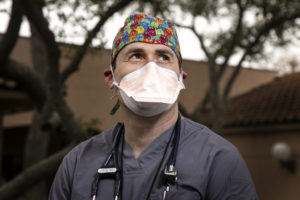As of earlier this week, more than 40% of Texas nursing homes were reporting active COVID-19 cases, with more than 900 residents testing positive.
The state does not differentiate whether those are severe or mild cases but, anecdotally, Dr. Michael Krol says the difference between this most recent so-called wave and earlier peaks appears to be “day and night.” Krol is an assistant professor at the University of Texas at Austin’s Dell Medical School, and is medical director at a handful of nursing homes in the Austin area.
“We have had small outbreaks [recently], but in the past we’ve had buildings with 40-and-up number of residents sick. And now we’ve had maybe five residents. And most of the residents are not having to go to the hospital, and we’re not having the crisis and death rates that we had in the past,” Krol told Texas Standard.

Dr. Michael Krol.
The reason for the difference, he says, is vaccinations. Early on, Texas prioritized long-term care facility residents and staff in the distribution of vaccines. State data shows more than 70% of nursing home residents are fully vaccinated. Alexa Schoeman is the deputy state ombudsman within the Long-Term Care Ombudsman program for Texas Health and Human Services.
“So, beginning around early December, we see a major drop-off that is correlated with when vaccines were available and being distributed to long-term-care facility residents,” Schoeman told Texas Standard. “So, while we’re still absolutely concerned about the trend upwards here, it’s really just more powerful evidence to show how important the vaccine is to protecting these folks.”
But when it comes to vaccinating staff, the story is different. About 50% of nursing home employees are fully vaccinated. But the idea of mandating vaccines for staff appears to be off the table for now in most cases because facilities are facing another big problem: staff shortages and burnout.
“Facilities are having trouble finding staff as it is, so they’re concerned about any other conditions that they might have to put on staff that would even lessen their staffing pool,” Schoeman said.
Krol says one reason staffing is so tight is because the delta variant surge is causing huge demand for health care workers across the board.
“As the hospitals are full to capacity, they’re able to pay higher rates for staff, including not just nurses, but also the certified nursing assistants that do the day-to-day labor,” he said.
So, as hospitals recruit these staff, nursing homes are left further understaffed, leading to even more burnout among those who remain.
“I’ve had a nurse recently call me, where, her husband has COVID-19 and she is trying to figure out how to take care of her husband and also trying to figure out how she can start helping the nursing home. And so it’s been really challenging on the staffing front and the burnout front,” Krol said.

Two employees at Hearthstone Nursing and Rehabilitation COVID-19 unit in Round Rock, Texas, in December 2020.
But on the positive side, Krol says the lockdowns and isolation that were necessary in nursing homes before the distribution of the vaccine have largely been avoided this time around. That’s also attributable to widespread use of protective equipment such as face masks for visitors and staff.
“The residents are now playing bingo and kind of interacting more with each other, and families are finally able to come in,” Krol said.
Schoeman says she hopes that can be maintained moving forward despite surging cases.
“Really, what we’ve learned from the past year is the devastating effects that social isolation has on long-term-care facility residents, and that those lockdowns and prohibitions from being able to see friends and family members and loved ones, it just caused a lot of emotional and physical harm, and didn’t ultimately end up keeping the virus out of the facility,” Schoeman said. “Currently, there’s still emergency rules in place that have limitations on visitors; they have to be screened and trained. … But facilities are required to allow visitation in accordance with state rules.”
Krol says he hopes all Texans interacting with older adults will keep these same lessons in mind – especially the lesson about the importance of vaccination.
“Making sure that everyone gets vaccinated, especially people that are high risk – and that would be anyone over the age of 65 – is so critical because when you have high percentage of people high risk, they will still have infections. But the amount of people going to the hospital, the amount of people getting really sick and the amount of people dying becomes much, much less. And that’s critical for us to do,” he said.













